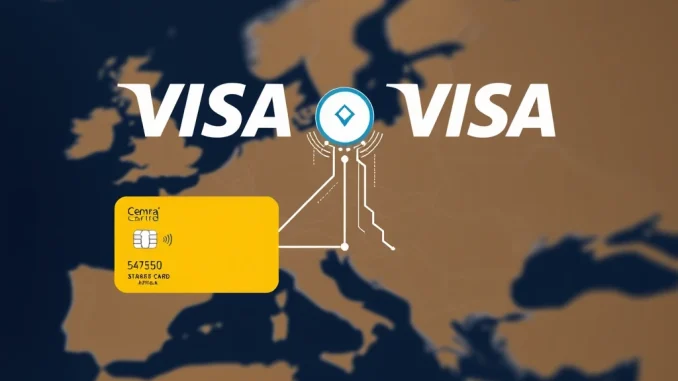
Visa, a global leader in digital payments, is making a significant stride into the future of finance by expanding its stablecoin operations across the Central and Eastern Europe, Middle East and Africa (CEMEA) region. This ambitious move is anchored by a strategic new partnership with Yellow Card, a prominent cryptocurrency exchange operating across Africa. This development signals a growing acceptance and integration of digital currencies, particularly stablecoins, within traditional financial frameworks. For anyone watching the evolution of payments and the increasing relevance of cryptocurrencies, this *Visa Yellow Card partnership* is a key indicator of where the industry is heading.
Understanding the *Visa Yellow Card Partnership*
At its core, this collaboration links Visa’s extensive payment network with Yellow Card’s established presence and expertise in the African cryptocurrency market. Yellow Card is known for providing easy access to crypto across numerous African countries, often catering to users who may not have access to traditional banking services. The partnership aims to leverage the strengths of both entities:
- Visa’s global reach, security infrastructure, and regulatory experience.
- Yellow Card’s deep understanding of the African market and its user base for digital assets.
While specific details of the operational mechanics are still emerging, the general direction points towards facilitating stablecoin-based transactions and potentially enabling users to move funds more efficiently between traditional finance and the crypto ecosystem using Visa’s rails.
Visa’s Broader *Stablecoin Strategy* Takes Shape
This regional expansion and partnership are not isolated events but rather part of Visa’s larger, evolving *stablecoin strategy*. The payment giant has been increasingly vocal about the potential of stablecoins and blockchain technology to modernize payments. According to CoinDesk, Godfrey Sullivan, Visa’s Senior Vice President and Head of Product and Solution for CEMEA, highlighted the company’s forward-looking perspective. Sullivan reportedly stated a significant expectation: by 2025, Visa anticipates that virtually all money-moving institutions will require a comprehensive stablecoin strategy.
This forecast from a major player like Visa underscores the projected mainstreaming of stablecoins. It suggests that stablecoins are no longer viewed as a niche crypto product but as an essential tool for efficient and modern financial operations globally. Visa’s actions, like this partnership, are steps towards making that future a reality.
The Significance for *CEMEA Crypto* Landscape
The CEMEA region is dynamic and diverse, presenting both unique opportunities and challenges for digital finance. Stablecoins offer particular advantages in markets where local currencies may experience volatility or where cross-border remittances are frequent and costly. By partnering with Yellow Card, Visa is tapping directly into this potential.
Benefits for the CEMEA region could include:
- Improved Remittances: Stablecoins can potentially offer faster and cheaper ways for individuals to send and receive money across borders, a critical use case in many African countries.
- Increased Financial Inclusion: By integrating with platforms like Yellow Card, the partnership could extend access to digital payment services to populations underserved by traditional banking.
- Economic Activity: Facilitating easier and more affordable digital transactions can stimulate local economies and enable participation in the global digital marketplace.
This move is likely to accelerate the adoption and integration of stablecoins within the existing financial infrastructure across CEMEA, potentially setting a precedent for other regions.
The Role of *Yellow Card Crypto* in the Partnership
Yellow Card’s position as a leading *Yellow Card crypto* exchange in Africa makes it a crucial partner for Visa’s expansion. Their established user base, regulatory navigation experience in multiple African countries, and understanding of local market needs provide Visa with a vital gateway. For Yellow Card, the partnership brings significant credibility and potential for growth by integrating with a global payment giant.
Yellow Card’s focus on making crypto accessible, often through mobile money and local payment methods, complements Visa’s goal of making stablecoin transactions practical for everyday use. This synergy is key to bridging the gap between traditional finance and the burgeoning crypto economy in the region.
What Does This Mean for the Future?
The *Visa stablecoin* initiative, bolstered by the Yellow Card partnership, points towards a future where digital currencies play a more integrated role in global commerce. It suggests that major financial institutions are actively building the infrastructure required for widespread stablecoin adoption. This isn’t just about enabling crypto enthusiasts; it’s about potentially transforming how businesses and individuals conduct transactions, especially in regions ripe for digital innovation like CEMEA.
Keep an eye on further developments from Visa and other payment networks as they continue to explore and implement stablecoin solutions. The 2025 target set by Visa’s executive highlights the urgency and importance they place on this digital asset class.
Conclusion
Visa’s strategic partnership with Yellow Card marks a significant milestone in the convergence of traditional finance and the crypto world, specifically focusing on stablecoins within the vital CEMEA region. This collaboration not only expands Visa’s stablecoin footprint but also underscores the growing necessity for financial institutions to embrace digital currency strategies. As Visa and Yellow Card work together, the potential for enhanced financial inclusion, more efficient remittances, and accelerated digital economic growth in Central and Eastern Europe, the Middle East, and Africa becomes increasingly tangible. This move solidifies the view that stablecoins are poised to become a fundamental component of the global payment landscape in the years to come.



